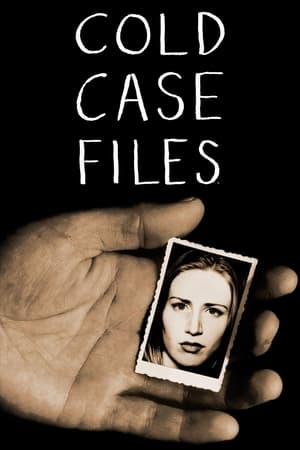The New Detectives
Case Studies in Forensic Science
The New Detectives: Case Studies in Forensic Science is a documentary true crime television show that aired two to three different cases in forensic science per episode.
Type: tv
Season: 9
Episode: N/A
Duration: N/A minutes
Release: 1996-06-10
Rating: 7.7
Season 1 - The New Detectives
1996-06-10
Young men shipped off to war would never return. Forensic experts work to tell their stories.
1996-06-11
This episode begins by showing how forensic scientists work backwards from a confession to concrete evidence. Before progressing to why cold cases shouldn't be forgotten about. It does not matter if it is minutes or years after the crime, these experts work to tell the stories of the victims.
1996-06-12
Scientists explore the differences between targeted and random poisoners, and the significance of disguising a targeted act of poison as a random act, such as the Tylenol case in Chicago.
Season 2 - The New Detectives
1997-04-22
Journey into the dark recesses and calculated madness present only in our worst nightmares; and in the minds of serial killers, such as Richard Chase - The Vampire Killer of Sacramento, Mike DeBardeleben - The Mall Passer, and John Wayne Gacy - The Killer Clown, to name just a few. Renowned FBI profiler Robert Ressler can reveal unseen clues about a killer simply by learning details about the crime. Investigative profiling discloses a killer's hidden motives.
1997-04-29
Forensic photographers are amongst the first people at a crime scene, capturing vital clues on film. What do the cameras capture that can't be seen first-hand and who are the men and women who analyse these camera clues?
1997-05-06
With DNA analysis just a few microscopic cells found at a crime scene can be used to convict a killer. Forensic scientists can analyze droplets of blood, hair fiber, or a piece of chewed gum to determine the identity of a victim or killer -- or to prove innocence.
1997-05-13
Forensic Entomology: Bug have been around for millions of years. Their habits surrounding death can tell these experts when the victim died.
1997-05-20
Forensic Sculpting: These experts can take nothing more than their knowledge, clay, and a skull and bring the victim to life. Once nameless victims can now have a name.
1997-05-27
Missing Person: In America nearly 1.8 million people are reported missing each year, factor in the world and that number triples. Using computer databases and other means victims are found, laid to rest…or never seen again.
1997-06-03
Identifying Burned Remains: Murder is hard to prove with no body, when the victim has been burned it is even more difficult. Fire does more than destroy evidence . . . it can keep the secrets you don’t want anyone to know.
1997-06-10
Explosives Investigations: A woman opens a box which explodes killing her. Soon to follow are five other bombs just as deadly as the first. This soon turns into a massive investigation leaving the experts to sift though the evidence.
1997-06-17
Fingerprinting: The backbone to forensic science, the fingerprint is a very effective way to identify victims and criminals. Not only are fingerprints used but also palm prints and foot prints. Data entered into massive databases make identifying people easy…when there is a hit.
1997-06-24
Handwriting Analysis: Every pass of the pencil leaves a little of ourselves behind. Taking the time to evaluate documents can tell the difference between suicide and murder.
1997-07-01
Black Boxes: A plane plunges toward the ground and upon impact little remains. The only possible survivor is the flight data recorder. This little black box could hold the answers to the last terrifying minutes.
1997-07-08
Forensics in the O.J. Simpson Murder Trial: The verdict is in Not Guilty of murder. O.J. Simpson emerges a free man. What was the evidence and could it be trusted? These experts break down the evidence could and could not tell us.
1997-07-15
Ballistics: A body with a gunshot wound to the head, the gun is next to the body. Was it suicide or murder? Every part of the gun can be analyzed for the correct answer.
Season 3 - The New Detectives
1997-12-02
Forensic psychologists delve into the minds of serial killers, explaining why, most often, they can be a friendly neighbor or a tenacious co-worker – the ones who hide their darkness better than anyone else.
1997-12-09
It is difficult to convict a murderer if the body can’t be found, but forensic science is finding ways to do it. A speck of blood, a piece of a fingernail or a strand of hair may now be enough evidence to prove a murder and capture a killer.
1997-12-16
Observing how the smallest bits of forensic evidence, such as carpet fiber or an eyelash, can seal a case. Included: how strands of hair indicted a killer.
1997-12-30
Plants help provide oxygen and nutrients for existence. In criminal investigations, a simple seedpod can provide the missing link by placing a suspect at a crime scene. Dirt left on shoes, tires or clothes can pinpoint a crime scene.
1998-01-06
While drugs can cure disease and ease pain, they can also be agents of murder. Toxicologists can examine blood and tissue to uncover cases where death is not as natural as it may seem – from slow arsenic poisoning to quick cocaine overdoses.
1998-01-13
A tool used to commit a crime can often be the same tool used to solve it. The pattern a machine leaves on an item, the unusual way a tool crimps a wire and even something as innocuous as the shape of a wood chip can lead to a killer.
1998-01-20
Advancement in science and technology are encouraging people to revisit the past in hopes of answering questions that have remained unanswered. Techniques from the 20th century are applied to cases dating back as far as ancient times.
1998-01-27
Investigators are always on the cutting edge of new forensic techniques that can help them solve cases more accurately. Advanced techniques allow crime solving to take on a new dimension, providing safer and more efficient ways to capture criminals.
1998-02-03
Insurance torchings, mob burnouts and arson murders: these crimes are designed to take all clues with them. But a case can be built from ashes. Arson investigators do everything from gathering physical evidence to mounting undercover operations.
1998-02-10
Because of new technologies, terrorism is a growing international threat. With the expertise of bomb squads, chemists and tool mark experts, bombs are deactivated and criminals are caught.
Season 4 - The New Detectives
1998-11-24
In the mind of an obsessive killer, raw desire replaces all reason and murder becomes an opportune means to an end. While forensic investigators follow the physical evidence, psychologists study the jumbled inner-workings of the criminal mind.
1998-11-17
The smallest of clues can solve even the biggest cases. Often the scales of justice are balanced by just a few milligrams of evidence – a couple of fibers, a smudge of blood or a strand of hair. Never underestimate the weight of these tiny clues.
1998-12-29
As technology becomes a bigger part of our lives, it’s becoming difficult to do anything without leaving behind an electronic trace. Cell phones and ATMs track our every move. When it comes to solving murders, this isn’t necessarily such a bad thing.
1998-12-08
Often, murderers will change or stage a crime scene, turning murder into suicide, pinning blame, or hiding the body completely. However, forensic investigators can detect masterful disguises and the truth can be found from clues at the scene.
1998-12-01
No crime scene is absent of clues. No matter how chaotic or how clean it may appear to be, the culprit is bound to leave something telling behind. Sometimes it’s nothing more than a fingerprint or shoe tread. Sometimes that’s all that’s needed.
1999-01-26
Men aren’t the only ones who kill. Though female killers usually choose less violent methods than their male counterparts, they’re equally as deadly and often more calculating. But thanks to forensics, they’re no more likely to get away with it.
1998-12-15
Contract killings allow someone to establish the perfect alibi. By hiring someone else to do his or her dirty work, a person can deflect guilt or twist the truth. Forensics is changing that, leading investigators to the employers of killers.
1998-12-22
Some people do get away with murder, at least for a while. Flush with their success, they murder again and again. But with each kill, they get sloppier, leaving investigators more and more clues, which eventually lead to their undoing.
1999-02-09
Poisoners are the most dangerous culprits in the crime world: smart assassins. They rely on their devious stealth and must put their victims at ease to earn their trust. And, usually, they don’t stop at just one victim.
1999-03-23
Some cases can’t be solved immediately. The passage of time can convince people to talk and new technologies can discover overlooked clues. Forensic scientists often reevaluate unsolved crimes and apply new means to solve them.
1999-03-30
The Texas Rangers were established in the 1800s to protect settlers from Native Americans. That role has evolved greatly over time to keep up with a changing society. Today, their job includes solving murders with advanced forensics labs.
1999-04-06
Forensics is not only used to solve murders. Drug trafficking has created a deadly criminal underworld and many forensic investigators are devoted to cracking these violent drug rings.
1999-04-13
Some of the best clues come from the least likely places. Seemingly meaningless objects – beer bottles, insects, doormats – have been used by forensics scientists to solve the most baffling of crimes. The murders of Virginia Russell, Hye-Yon Smith and Janet Overton are evidence of this.
1999-04-27
Some crime writers know just as much about crime as a police officer, investigator or any criminal. Using combined perspectives from law enforcement, journalism and criminal psychology, writers provide new and exciting first-hand accounts of murder.
1999-05-18
A good coroner can deliver what is necessary to solve a crime, while a bad one can destroy an otherwise solid case. Two of the country’s most respected coroners provide an inside look into their jobs, sharing their insights into crime solving.
Season 5 - The New Detectives
1999-10-05
Solutions to atrocious crimes can hinge on the smallest of clues. Even with advanced technology, vision remains an important tool. Forensic investigators must train their eyes to find the full story of a murder written in a single scrap of evidence.
1999-12-26
There’s an old saying that a burden shared is a burden halved. But when people team up to commit murder, the weight of their guilt remains just as heavy. Investigators must rely on forensic science to capture partners in crime.
1999-10-19
There’s never a good reason for murder but some killers are especially cruel – choosing their victims at random or with no apparent motive and then expertly covering their tracks. These crimes may seem unsolvable, but telling clues remain.
1999-11-02
The great outdoors may offer clues to solving heinous crimes. Seed germination and the presence of certain insects provide vital information about murders. It takes the skilled eyes of a forensic entomologist and botanist to decipher nature’s clues.
1999-11-16
Poison is the subtlest murder weapon and poisoners are sometimes the most brutal killers, harming their victims over time to disguise the murder. Investigators must see through the unusual circumstances to bring these murders to light.
1999-12-14
What does it take to prove murder if the victim cannot be found? Forensic investigators must go to great lengths to catch the killer when the victim is only presumed dead.
1999-12-21
When lovers turn on each other or marriages fail, some coldblooded spouses find a gruesome way to gain an uncontested divorce: murder. Forensic scientists must piece together the mystery of love gone awry to catch these killers.
2000-01-11
There’s no statute of limitations on murder, so as a case turns cold and clues become scarce, investigators must rely on modern forensic technology to solve the crimes and catch the killers.
2000-01-25
Every family has its secrets and sometimes blood relations lead to bloodshed. When murder becomes a family affair, investigators must turn to science to uncover family plots.
2000-02-08
Some people murder for love, others murder out of hatred. But sometimes people kill for the money. When greed is the motive, investigators must make every clue pay off in these murder-for-profit cases.
2000-02-15
For some killers, once is never enough. Often, cold and calculated serial killings are more difficult to solve than violent crimes of passion. For investigators, the challenge is steep when the killers murder by numbers.
2000-03-28
When there’s a difficult case to crack, agents of the Bureau of Alcohol, Tobacco and Firearms can be called in to help. These investigators have the means to tackle crimes involving drugs, arson and weaponry.
2000-04-04
Sometimes arson fires are set to cover a different, more heinous crime – such as murder. But killers are wrong to think that fire destroys all vital clues. Arson investigators can pull evidence from scorched rubble to ignite the flames of justice.
Season 6 - The New Detectives
2000-10-10
Often, the witnesses of a crime are also the main suspects. They’re able to manipulate the truth to throw off the authorities. When a murder is committed and deceit clouds the evidence, investigators turn to forensics to uncover the truth.
2000-10-24
A simple clue can provide the missing link by placing a suspect at the scene of the crime. Dirt left on shoes, tires or clothes can pinpoint where the crime occurred. It takes the skilled eye of a forensic investigator to follow the trail.
2000-11-21
Approximately 1.8 million Americans are reported missing each year. Some are runaways who eventually find their way home but others simply disappear without a trace. When foul play is suspected, investigators turn to forensics to find the missing.
2000-11-07
Some people don’t care who they kill; they just want to hurt innocents. Bombers, snipers and spree killers: these murderers are the hardest to catch because they have no connection to their victims, people in the wrong place at the wrong time.
2000-12-12
Sometimes blood relations lead to bloodshed. When money is the motive, murder can rip at the very foundation of family and marriage. When homicide becomes a family affair, investigators must turn to forensics to shed light on these crimes.
2000-12-26
Even the most puzzling cases can be solved with the tiniest of residue left behind at the crime scene. Trace evidence and paint analysis can be used to track down a serial killer or dog hair can be used to link separate murders to a single suspect.
2001-02-01
Poison is an almost invisible form of death and is often interpreted as a heart attack or underlying health issue. But when foul play is suspected, toxicologists must look for hidden clues in blood and tissue to bring these murders to light.
2001-02-13
Some people do get away with murder, at least for a while. Thrilled by their success, they tend to kill again and again. But with each crime they leave behind more clues for investigators. In this episode, two serial killers are profiled.
2001-03-06
At the scene of a murder, sometimes the only clues to the killer come from the victim. Forensic anthropologists use skeletal remains to decipher the clues written in the bones to bring the murderers to justice.
2001-04-17
Time of death is an important consideration in an investigation but when a killer destroys the body, even the best medical examiner would be at a loss about how to calculate death's time frame. Forensics has its own techniques for solving these crimes.
2001-05-01
Accidental deaths, suicides, disappearances and fires: they’re an everyday part of an insurance investigator’s job. But these cases shouldn’t be taken at face value. Forensics has become a vital tool in exposing insurance fraud.
2001-05-22
Drowning deaths often look like accidents and over time water can destroy the few clues the killer may have left behind. Investigators must turn to forensic science to solve homicides in which the victims were found in bodies of water.
2001-09-11
A dog can be a dead man’s best friend. Some dogs have been trained by law enforcement to sniff out corpses, drugs, explosives and missing persons. Even with advances in science, a dog’s nose is often first to find fundamental clues.
Season 7 - The New Detectives
2001-09-18
For homicide investigators, it’s a race against time when they track their deadliest foe: a serial killer who murders to feel alive.
2001-08-28
When a killer turns a gun on a victim, ballistic analysis is key to cracking the case. Each shot fired leaves behind its own clues, allowing scientists to target murderers with deadly aim.
2001-09-04
When theft is committed, something valuable is stolen. But when a criminal needs a new identity, theft becomes lethal.
2001-09-11
Sometimes, seemingly small and insignificant clues – three hairs, microscopic fibers, a paint chip – become a victim’s silent witness and help solve even the most baffling of cases.
2001-09-25
When abduction turns to murder, forensic science is a vital key to finding justice for the victims of a kidnapper’s deadly intentions.
2001-12-11
The tread of a tire, a single shoe print or even the shape of a bruise can help investigators track down murderers.
2001-12-18
Investigators rely on forensic odontology – the examination of dental evidence – to identify a body from a single tooth and to catch two ruthless killers from their bite marks.
2002-01-01
The law enforcement agency of the United States Navy and Marine Corps uses forensic science to solve perplexing murders and fulfill their motto: “To the living we owe respect; to the dead, we owe the truth.”
2002-02-19
Years after a murder has been committed, investigators use modern technology and advanced DNA analysis to shed new light on crimes that have gone unpunished for far too long.
2002-03-05
Forensic scientists find clues written in blood as they investigate the murders of three women who were killed by men who once loved them.
2002-02-26
The elements of nature can reduce a body to bones in a matter of weeks. Combining art and science, forensic anthropologists can give victims a face long after they’ve been forgotten.
2002-03-19
Sometimes, the wrong people are punished for crimes they did not commit. Forensic scientists use DNA analysis to overturn convictions of these innocent men and women who have spent years behind bars.
2002-03-26
A teenager is abducted on a shopping trip. Two hikers go missing on the Appalachian Trail. A grandmother never returns home from work. Forensic artists turn witness statements into pictures to recreate the face of their killers.
2002-09-10
A millionaire is murdered for a stash of buried treasure. A young woman dates violent men, only to be killed by her best friend. When real crimes are stranger than fiction, forensic science can sort fact from fantasy.
2002-05-21
For the forensic entomologist, insects that nest in corpses are like witnesses to the crime. By studying their behavior, scientists learn everything -- from when a murder was committed to what sort of weapon was used.
2002-06-11
Photography has long been a fundamental tool in homicide investigations. A single image can hold enough information to identify a suspect and preserve vital clues long after a witness’s memory fades.
2002-06-25
When teenagers are driven to kill, their victims are not the only ones to suffer from their violent crime. In three such cases, the families of the killers and their communities become victims of these young criminals.
2002-09-24
Philadelphia’s Vidocq Society, named after an 18th century French detective, is one of the world’s most unusual crime-solving organizations – a members-only club made up of forensic professionals. Witness these sleuths solve impossible cases.
Season 8 - The New Detectives
2002-10-15
For some killers, murder can be a lucrative business. When a victim has been targeted for death, investigators must dig deep and go beyond the obvious to uncover a murder for hire.
2002-12-03
Sometimes the cause of death does coincide with the scene of the crime. When an untraceable poison is used as a murder weapon, investigators rely on forensic toxicologists to follow a killer’s tracks and expose a toxic death.
2002-12-10
Lies, deception and contradicting witnesses can often throw investigators off the trail of justice. But when indisputable evidence refutes a killer’s story, police must use the clues to piece together the truth.
2002-12-17
Sometimes when a death seems to be accidental, forensics can reveal the deception just below the surface. Law enforcement uses a variety of techniques to uncover the hidden truths that reclassify cases from tragic accidents to cold-blooded homicides.
2002-12-24
A murdered woman is found stuffed in the boot of her car, and a routine investigation reveals a wife may not have abandoned her family on purpose. When everyday substances reveal hidden clues that break a homicide case, those substances become the elements of murder.
2003-01-14
Most victims are meticulously chosen by their murderer because of a connection or because they match a set of criteria. The most terrifying cases of murder occur when the killer appears to choose victims at random.
2003-02-11
Killers often will try to cover up their crime by hiding the remains of their victims. Sometimes bodies may lay hidden for years before they are discovered. That’s when forensic scientists are called upon to reveal buried clues.
2003-02-18
When a victim is killed at point-blank range, police often suspect that a friend or acquaintance is to blame, because for a stranger it would otherwise prove too difficult. Investigators must use the clues to track down the most unlikely killers.
2003-03-25
In most murder cases, police rely on motive to pursue a killer. But when the murderer is a stranger, the crime may go unsolved for years. Investigators must employ an arsenal of forensic techniques to trace these seemingly random lethal encounters.
2003-04-22
When killers are driven by jealousy, rage and desire, their desperation is evident in both the crime and their efforts to cover their tracks. But forensic science can reveal even the smallest mistake to solve these crimes of passion.
2003-05-13
When murderers hide or destroy the remains of their victims, forensic scientists must reconstruct the scenes and prove murder for an absent witness.
2003-07-17
Often killers are careful to not leave any fingerprints behind. But the methods of the murder itself can leave a lasting impression on authorities, especially when the tools of a killer’s trade leave a victim marked for death.
2003-06-10
Anytime, anywhere, people disappear – and sometimes these disappearances end in tragic murder. Kidnappers always leave clues behind, but chasing them takes time, hindering investigators’ attempts to solve these fatal abductions.
2003-07-19
Some killers choose to hide their victims and investigators must then rely on forensics to uncover proof of murder. From identifying remains to uncovering post-mortem clues, medical examiners are integral in solving some of the most brutal crimes.
2003-08-19
At a crime scene, anything left behind or moved out of place is considered a clue. But a fire can extinguish everything in its path, challenging forensic investigators at every turn.
2003-07-08
Solving crimes may begin with intuition but advanced science provides investigators with irrefutable proof to uncover staged accidents. When criminals go to great lengths to hide their crimes, skeptical investigators must remain undaunted.
2003-08-05
When victims of murder knew their killers, they can be caught off guard. The killers rely on their intimate knowledge to pull off the perfect crime. But even the best-laid plans leave traces of the forsaken trust.
2004-01-03
Coroners play a vital role in piecing together the final moments of someone’s life. Los Angeles County coroner Julie Wilson provides an in-depth look into the science of death, as well as the techniques and methodology used by coroner investigators.
Season 9 - The New Detectives
2003-10-28
Sometimes those closest to a victim can be the most dangerous. Beneath a layer of trust can lurk a deadly obsession. In these cases, authorities employ an arsenal of forensic techniques to uncover the twisted path of lies that leads to murder.
2003-11-25
Often, a killer will build the victim’s trust before he or she attacks. In this episode, New Mexico police search for a missing teenager who disappeared from a local skating rink. Authorities suspect the two friends she was last seen with.
2004-01-10
Marriage is one of the tightest bonds two people can have, until lies and deceit drive one of them to kill. In this episode, forensic experts are employed to link a woman’s husband to her violent murder and uncover a murder disguised as an accident.
2004-01-13
Sometimes the faintest fingerprint or tire track is all investigators need to solve even the most brutal of crimes. When a woman’s body is discovered in a field, detectives employ a rarely used technique to bring her killer to justice.
2004-01-17
A house fire in California turns into a murder investigation when authorities discover that the victim’s best friend and personal manager had recently cleaned out her bank account.
2004-01-29
A killer will often try to disguise the victim’s body in an attempt to the hide the actual cause of death; however, forensics cannot be fooled. In this episode, authorities use reverse DNA testing to identify remains and solve an old crime.
2004-03-31
When money is the motive, there is no limit to what a killer will do to get away with their fortune. When officers find the dismembered remains of a young man, they also discover his girlfriend recently took out an insurance policy on the deceased.
2004-03-16
Sometimes, cooperation from people who are not associated with a crime in any way is the only link between a criminal and the clues left behind for forensic experts. This episode examines cases in which good Samaritans help solve puzzling crimes.
2004-03-27
Even ordinary objects, when used to kill, carry enough evidence for forensic scientists to piece together the most complicated murders. In this episode, criminals are brought to justice with evidence found on mundane, household objects.
2004-04-10
The most sacred of vows are sometimes not enough to stop a serious desire. In this episode, a nurse suspects a patient’s husband of attempted murder by poisoning and a man stages his depressed wife’s murder as a suicide.
2004-04-24
Often, criminals misuse the trust they’ve built with their victims to commit heinous misdeeds. A family discovers the mummified remains of a pregnant woman; a nurse notices an unusually high number of deaths in an ICU unit and suspects foul play.
2004-05-08
When the amount of money is substantial, a person can be motivated to do terrible things to someone they love. Police discover that a large life insurance policy was motive for a man’s murder. A woman hires help to cover up her husband’s death.
2004-06-12
Murdering a child is perhaps the most heinous of crimes. But no matter how defenseless a killer believes a young child to be, there is no hiding from the clues left behind.
2004-07-17
Forensic science has advanced so much that even the oldest remains still share the clues necessary to convict a killer. Investigators use DNA to solve a murder case from 1980.
2004-08-14
Blood can be the most telling evidence of a murder and often it is the only thing investigators have to link a killer to his or her victim. Forensic scientists and medical examiners look at blood spatter patterns to determine how someone was killed.
2004-08-28
Whether it is a fingerprint or a single bullet, sometimes it is the smallest piece of evidence that is needed to crack the biggest cases. In this episode, detectives use an ingenious technique to find the bullet that killed an elderly man.
2004-09-18
When an unexpected crime occurs with no eyewitnesses, very few clues and the killers on the run, authorities must rely on forensic science to discover the fatal twist in these cases.
2004-10-31
Murderers will go to great lengths to keep their crimes concealed, but forensic evidence is impossible to cover up. In this episode, authorities rush to identify bodies found in drum barrels and locate several missing women linked to the killer.
YOU MAY ALSO LIKE


















